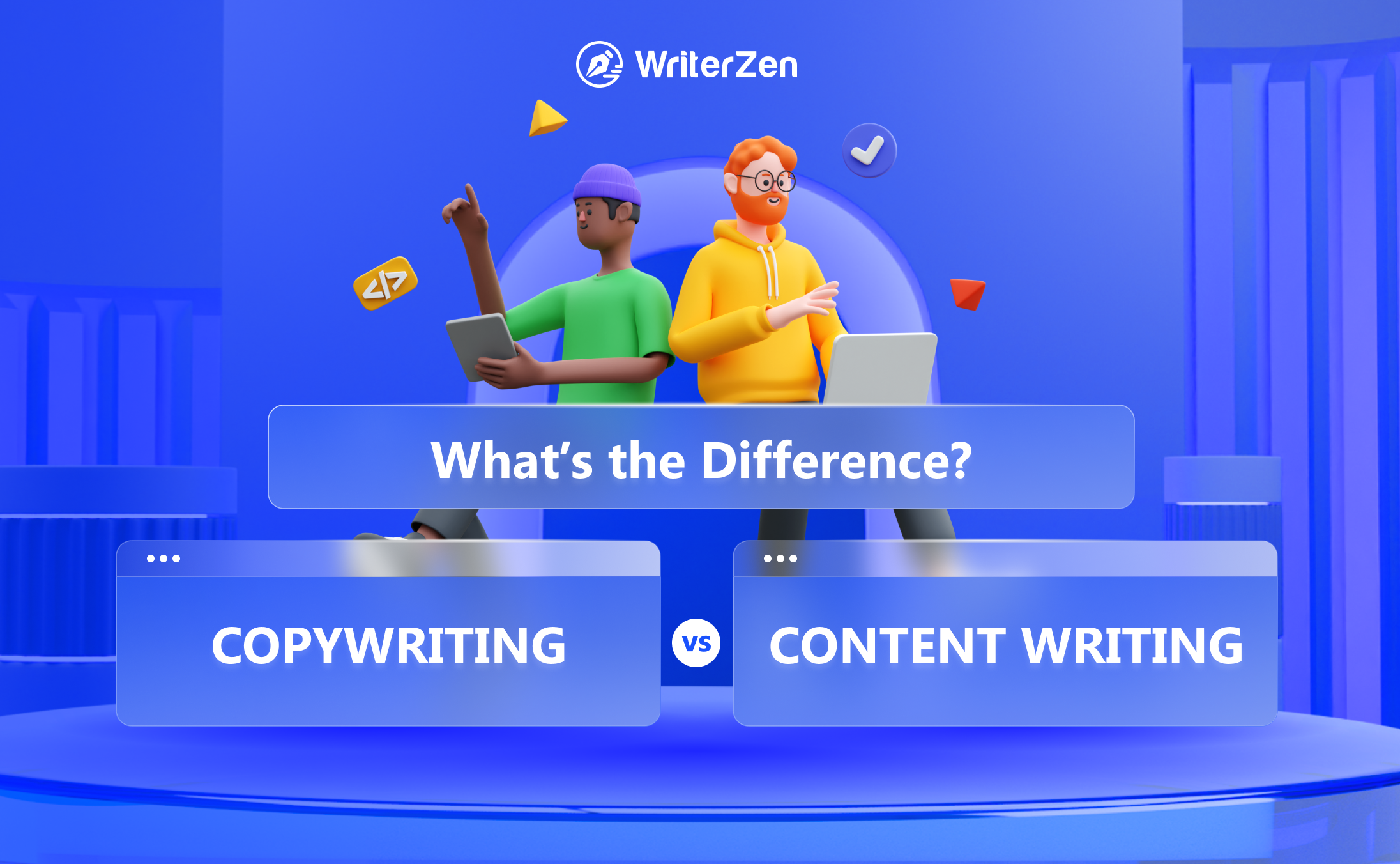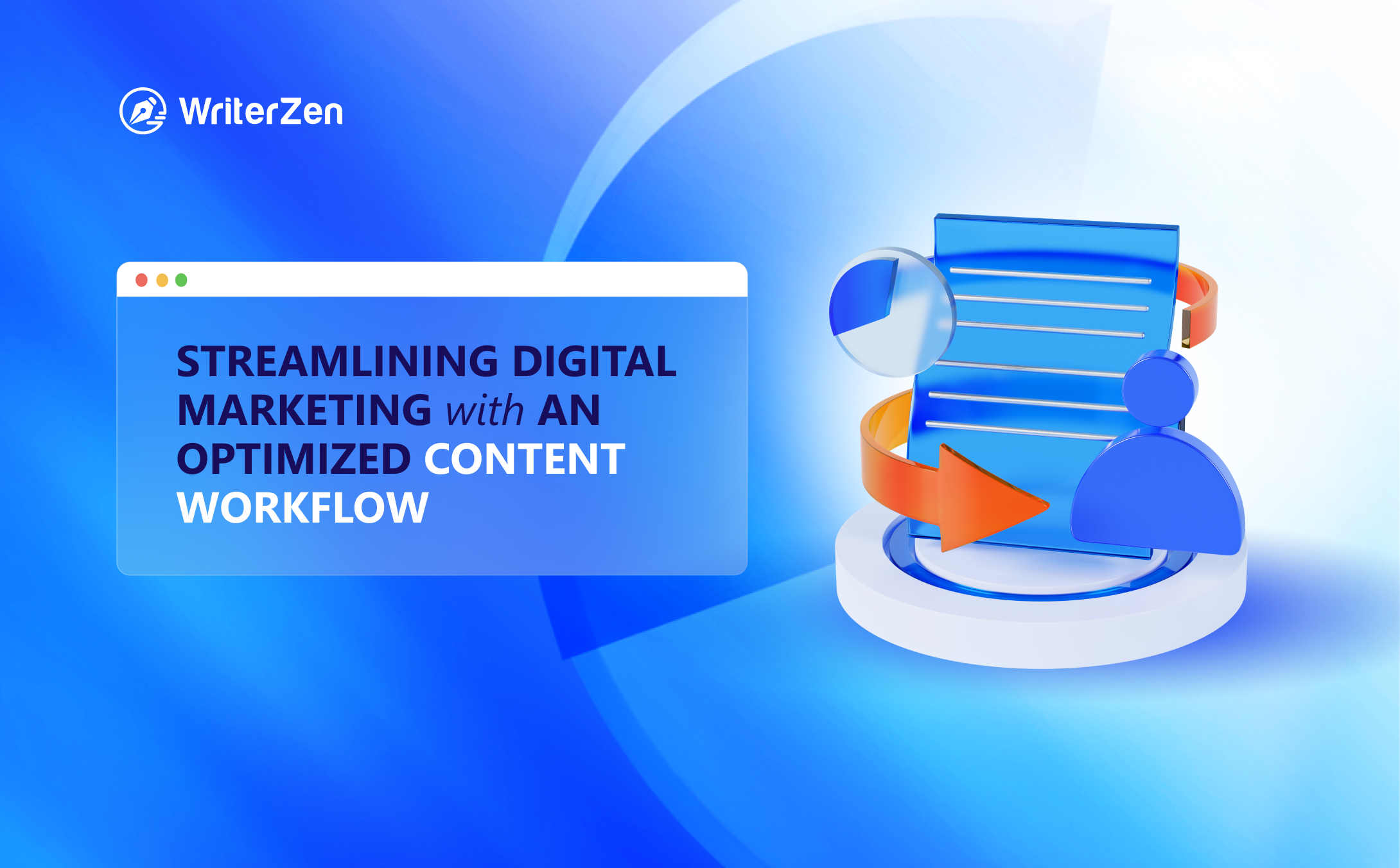Direct-response copywriting is the strategic backbone of effective digital marketing, designed to prompt immediate action from the audience.
This comprehensive guide will explore the intricacies of direct-response copywriting, dissecting its essential components, understanding its mechanisms, and providing practical tips to craft compelling copy that drives conversions and sales.
Definition of Direct-Response Copywriting
Direct-response copywriting is the art of crafting persuasive and purposeful content to elicit an immediate response from the reader. This response could be purchasing, subscribing to a service, downloading an ebook, or any other desired action.
Unlike general content, direct-response copy is laser-focused, aiming to captivate the reader's attention and guide them seamlessly toward taking a specific action.
How Direct-Response Copywriting Contributes to ROI
Direct-response copywriting can generate a significant return on investment (ROI) for organizations. By crafting compelling and targeted messages that prompt immediate action, businesses can see substantial benefits in increased sales, higher conversion rates, and improved customer engagement.
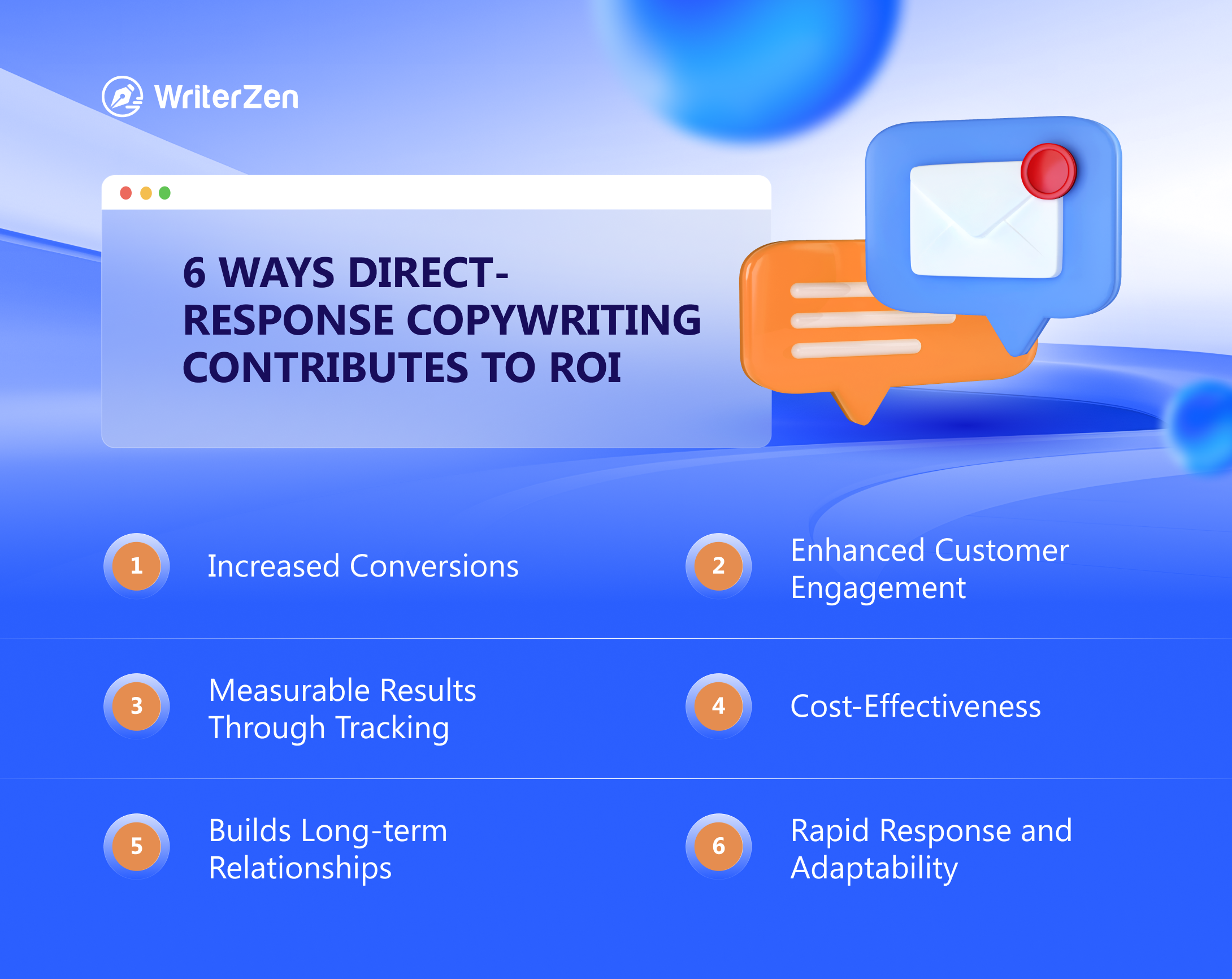
Here’s how direct-response copywriting contributes to ROI:
Increased Conversions
Direct-response copywriting is designed to be persuasive and action-oriented. Communicating a product's or service's benefits and compelling call-to-action encourages visitors to purchase or take another desired action. The focused and persuasive nature of direct response copy increases the likelihood of conversions, directly impacting ROI.
Enhanced Customer Engagement
Engaging and relevant direct response copy grabs the audience's attention. Addressing their specific needs and concerns creates a connection. When customers feel understood and valued, they are more likely to engage with the brand. Higher engagement leads to increased trust, brand loyalty, and, ultimately, more sales.
Measurable Results through Tracking
One of the significant advantages of direct response copywriting is its measurability. Marketers can track the performance of specific campaigns, emails, or advertisements in real time.
Organizations can refine their strategies by analyzing click-through rates, conversion rates, and customer responses. This data-driven approach allows businesses to invest more in what works, maximizing ROI.
Cost-Effectiveness
Compared to traditional advertising, direct response copywriting can be highly cost-effective. Brands can optimize their marketing budgets by targeting specific audience segments and tailoring messages accordingly. Efficient use of resources ensures that the money spent on advertising generates a higher return, contributing significantly to overall ROI.
Builds Long-Term Relationships
Effective direct-response copywriting focuses on immediate sales and building enduring customer relationships. By creating positive experiences and meeting customer needs, businesses can foster loyalty. Satisfied customers are more likely to return for future purchases and recommend the brand to others, ensuring a steady revenue stream.
Rapid Response and Adaptability
Direct response copy can rapidly adjust in real time. This agility allows organizations to respond swiftly to market changes, customer feedback, and emerging trends. Being adaptable ensures that the marketing message remains relevant and resonates with the audience, maximizing the chances of conversions and, consequently, ROI.
Four Key Elements of Direct-Response Copywriting
Direct-response copy is a masterclass in conciseness. Every word is carefully chosen to convey meaning without unnecessary embellishment. Clarity ensures the reader comprehends the offer and the action required, reducing confusion and friction in decision-making.
Incorporating these four elements ensures that direct response copywriting is informative but also persuasive and actionable, motivating the audience to respond promptly and positively to the message.
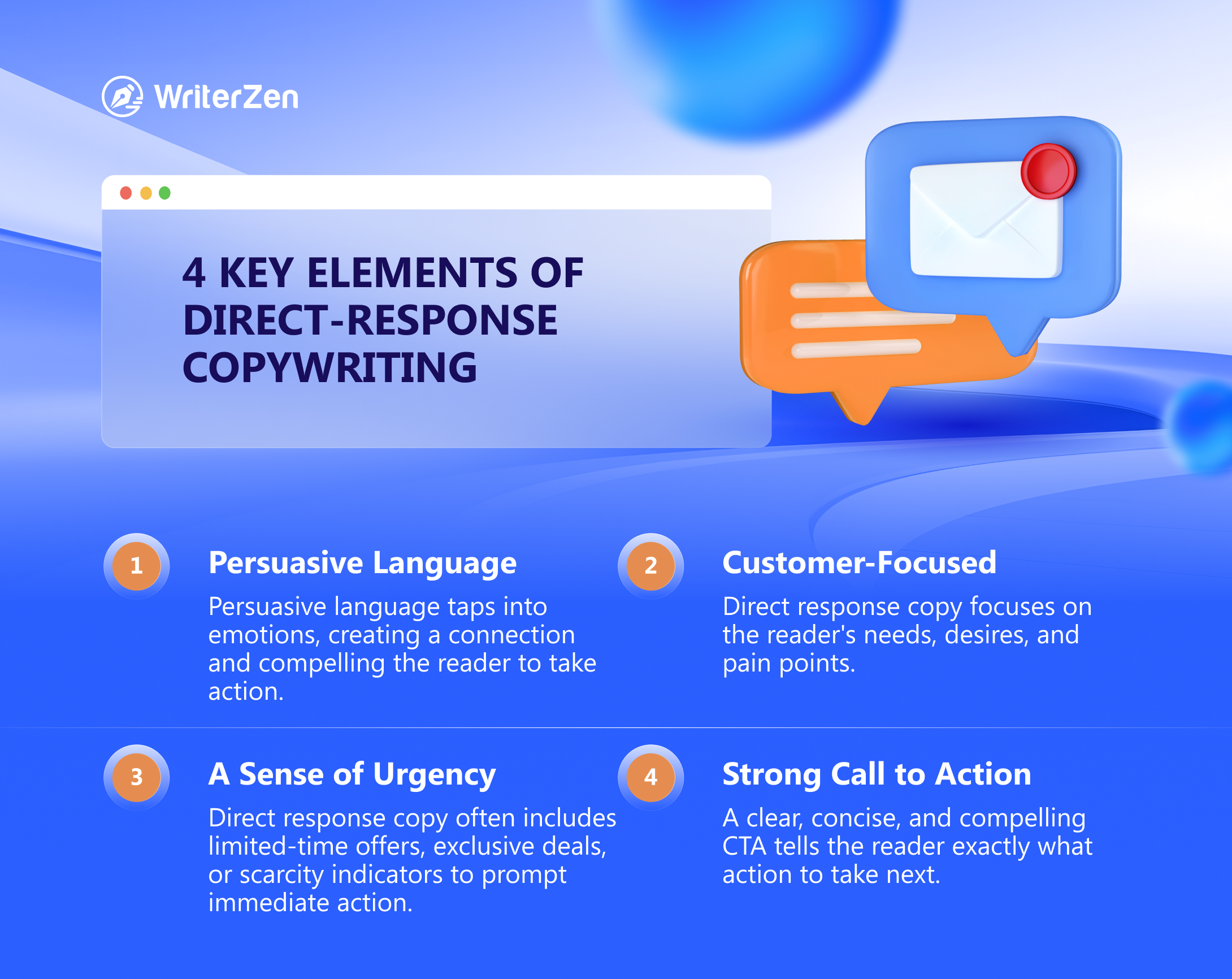
Persuasive Language
Direct response copywriting employs a persuasive tone that resonates with the audience. It's not just about listing features but crafting a narrative that convinces the reader of the product or service's value. Persuasive language taps into emotions, creating a connection and compelling the reader to take action.
Customer-Focused
Understanding the customer is paramount. Direct response copy focuses on the reader's needs, desires, and pain points. Language needs to address these specific concerns, making the reader feel understood. Additionally, the layout of the copy, including headings, bullet points, and clear sections, enhances readability, ensuring the message is easily digestible.
A Sense of Urgency
Creating a sense of urgency is a powerful motivator. Direct response copy often includes limited-time offers, exclusive deals, or scarcity indicators to prompt immediate action. This urgency convinces the reader that acting now is essential to secure the benefits, thereby increasing the likelihood of a response.
Strong Call to Action
The call to action (CTA) is the linchpin of direct response copywriting. It's a clear, concise, and compelling directive that tells the reader exactly what action to take next. Whether it's "Buy Now," "Subscribe Today," or "Limited Stock, Act Fast," a strong CTA leaves no room for confusion, guiding the reader toward the desired action.
How Does Direct Response Copywriting Work?
Direct-response copywriting begins with a clear understanding of the primary goals specific to your email or marketing campaign. Defining these goals is the foundation for the entire copywriting process.
Whether the objective is to drive sales, increase newsletter subscriptions, promote a new product, or encourage social media engagement, having well-defined goals provides direction and purpose to the copy.
Direct-response copywriting often taps into emotions, creating a connection with the reader. Whether through empathetic language, relatable stories, or highlighting the positive emotions associated with the product, emotional appeal enhances engagement and fosters trust.
It guides the choice of language, the structure of the message, and the overall tone, ensuring that every element of the copy works cohesively to achieve the desired outcome. By aligning the message with these goals, direct response copywriting becomes a powerful tool for driving immediate and meaningful actions from the audience.
Tips for Direct-Response Copywriting
Mastering the art of direct-response copywriting is essential for any marketer or business owner looking to drive immediate action and generate measurable results. Here are some tips for you to pick up:
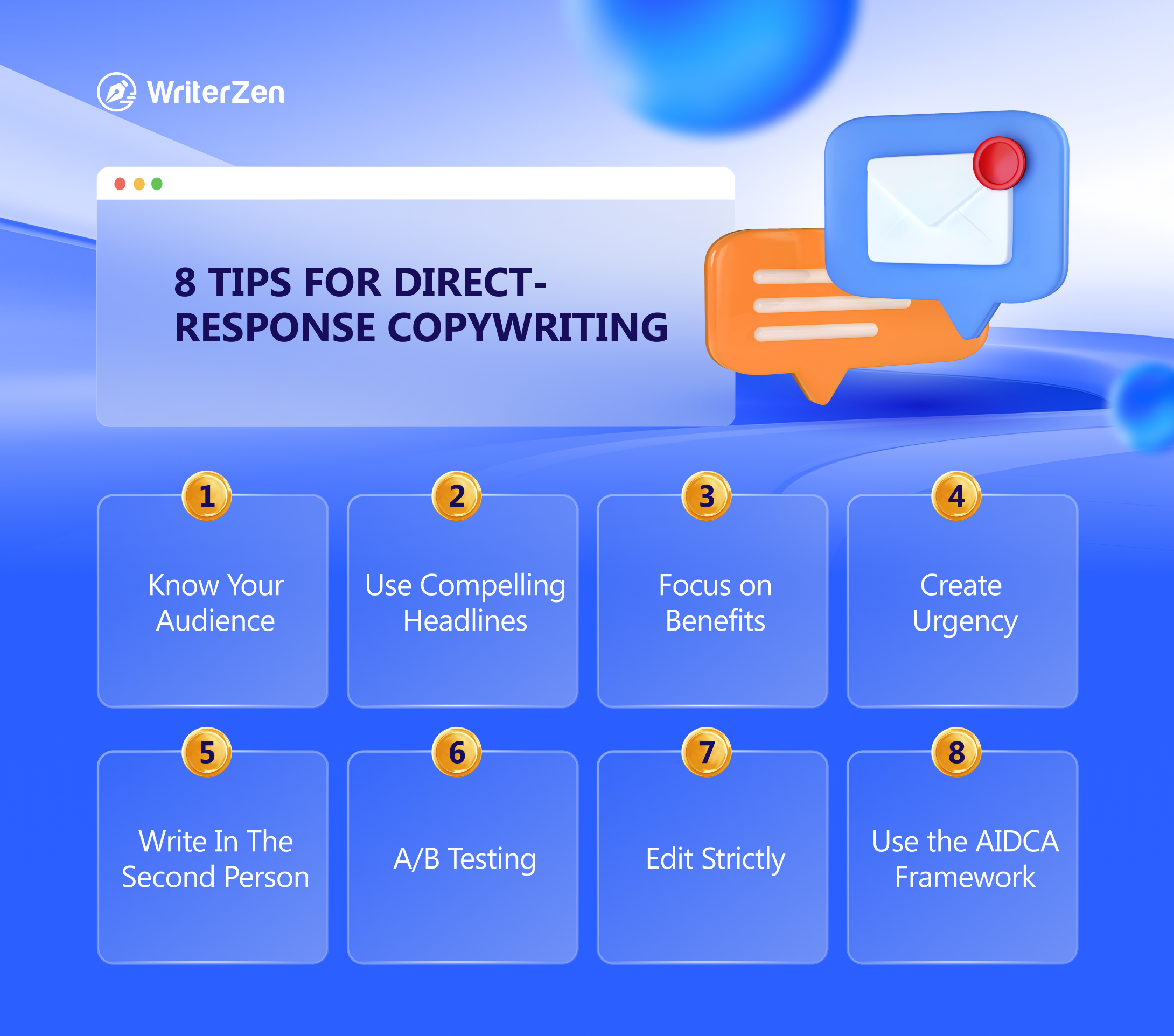
Know Your Audience
In-depth research into your audience's demographics, preferences, and behaviors is crucial. Understanding their needs lets you craft copy that speaks directly to them, making your message more compelling and relatable.
Use Compelling Headlines
The headline is the gateway to the rest of the content. If it fails to captivate the audience's attention, the chances of them engaging with the rest of the copy diminish significantly. A compelling headline grabs attention and sets the tone for the entire message, enticing readers to delve deeper into the content.
Focus on Benefits
Highlight the tangible benefits of your product or service. Explain how it addresses a problem, simplifies a task, saves time, or improves the quality of life. Benefits create a compelling reason for the reader to take action.
Create Urgency
Incorporate elements that create a sense of urgency, such as limited-time offers, exclusive deals, or limited stock. Urgency compels readers to act promptly, fearing they might miss a valuable opportunity.
Write in The Second Person
By addressing the reader directly, using pronouns like "you" and "your," you create a personal connection. This approach makes the reader feel involved and engaged, increasing their likelihood of responding to your call to action.
A/B Testing
Continuously test different variations of your copy and CTAs. A/B testing lets you identify what resonates best with your audience, enabling data-driven decisions for optimal results: test headlines, CTA wording, color schemes, and even the placement of elements on the page.
Edit Strictly
Direct-response copywriting demands precision. Edit your copy ruthlessly, eliminating redundant words and ensuring every sentence contributes to the overall persuasiveness of the message. Concise copy keeps the reader engaged and focused on the call to action.
Use the AIDCA Framework
AIDCA stands for Attention, Interest, Desire, Conviction, and Action. Effective direct-response copywriting starts with an attention-grabbing headline and a compelling product description to capture interest.
Building conviction with evidence and testimonials, stimulating desire through emotional connection, and concluding with a strong call to action guides readers seamlessly from attention to decisive action, maximizing engagement and conversions.
Best Examples of Direct-Response Copywriting
Apple
Apple's direct-response copywriting for the iPhone exemplifies the art of anticipation and intrigue. The tagline, "This changes everything. Again," encapsulates the essence of direct response copywriting by creating a sense of urgency and excitement.
By implying a revolutionary shift, Apple triggers curiosity and prompts immediate engagement. The concise yet impactful wording compels the audience to explore further, instigating a desire to discover how this innovation could transform their lives.
This example showcases the power of concise messaging and the ability to incite immediate interest, hallmarks of effective direct-response copywriting.
Airbnb
Airbnb's direct-response copywriting brilliance lies in its emotional resonance and ability to evoke profound feelings. The "Belong Anywhere" tagline taps into the deep-seated human desire for connection, adventure, and belonging. It doesn't just sell a service; it sells an experience, a sense of home wherever you go.
By addressing the universal longing for authentic travel experiences and a sense of belonging, Airbnb prompts the audience to respond emotionally. The tagline acts as a powerful call to action, urging users to fulfill their desires by booking accommodations through Airbnb.
This example illustrates how direct-response copywriting, rooted in human emotions and aspirations, can prompt immediate action and foster a strong connection between the brand and its audience.
Slack
Slack's "Be Less Busy" tagline addresses a prevalent workplace pain point: the overwhelming sense of busyness and communication overload. This concise yet impactful message resonates with professionals who feel inundated with tasks and messages, instantly capturing their attention.
Slack's brilliance lies in promising a tangible solution. By indicating that Slack can help individuals "Be Less Busy," the copy creates a compelling proposition. It doesn't just sell a product; it offers a remedy to a specific problem. The tagline suggests that Slack can streamline workflows, enhance collaboration, and simplify communication, making professionals' lives more manageable.
In this example, Slack's direct-response copywriting identifies a universal struggle and offers a clear, effective solution. It highlights the core principle of addressing the audience's pain points and presenting the product as the key to resolving their challenges, making it a powerful example of persuasive and action-driven copywriting.
Final Thoughts
In conclusion, direct-response copywriting is a potent tool in the digital marketer's arsenal, capable of driving substantial results when wielded with expertise. By understanding the key elements, honing your skills, and drawing inspiration from successful examples, you can craft compelling copy that resonates with your audience and drives conversions.
As you embark on your direct-response copywriting journey, remember clarity, clear value, persuasive CTAs, and emotional appeal are your allies in the quest for marketing success. Master these elements, and you'll unlock the true potential of your digital marketing efforts.




